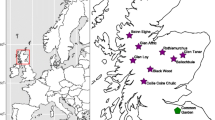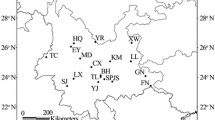Summary
Variation in leaf longevity of gymnosperms has received surprisingly little attention despite its likely adaptive significance. Pinus longaeva, a pine of arid, subalpine environments in the western United States, has the record among conifers for needle longevity, with a maximum dwarf shoot (needle fascicle) retention time of up to about 45 years. Most low elevation pines have dwarf shoot retention times (DSRs) of two to four years. Literature data for the 37 species of Pinus native to the United States and Canada and field data for eight taxa (21 populations) of pines growing at various elevations in California each show a strong positive correlation between elevation and DSR, respectively, r=+0.65, df=35, p<0.001 and r=+0.82; df=19, p<0.001. We propose that extended needle fascicle longevity represents an adaptation to arid and especially high elevation environments. Field data from native stands and common gardens indicate that differences between taxa in DSR relate to both genetic and environmental factors. When grown at the same sites certain species (eg, P. longaeva, P. monophylla) had much longer DSRs than others, indicating a genetic basis for differences in needle fascicle longevity. For six of seven taxa that were each studied at more than one elevation there was a statistically significant increase in DSR in going from the lowest to the highest elevation site, indicating strong environmental control of needle fascicle longevity.
The physiological control of dwarf shoot senescence and abscission is poorly understood. For P. longaeva dwarf shoots of a particular age class are not shed simultaneously; rather there is a more or less gradual attrition of dwarf shoots from the long shoot. Although different types of long shoots of pines are known to differ physiologically, for P. longaeva there was no consistent difference in DSR on various types of lateral long shoots (eg, vegetative, pollen cone-bearing, seed cone-bearing), nor was there a statistically significant difference in DSR on trunks versus on their lateral long shoots. In addition, for P. contorta ssp. bolanderi and P. muricata needle fascicle longevity was not affected by the degree of edaphically induced dwarfing (ie, stunting) of the trees.
Similar content being viewed by others
References
Abrams L (1923) Illustrated flora of the Pacific states: Washington, Oregon, and California, vol 1. Stanford University Press, Stanford [1940 edition with minor corrections]
Bailey DK (1970) Phytogeography and taxonomy of Pinus subsection Balfourianae. Ann Missouri Bot Gard 57:210–249
Barnard C (1926) Preliminary note on branch fall in the Coniferales. Proc Linn Soc New South Wales 51:114–128
Bornman CH (1978) Welwitschia: Paradox eines verdorrten Paradieses/paradox of a parched paradise. C Struik Publishers, Cape Town [dual German-English text]
Britton NL [assited by JA Shafer] (1908) North American trees. Henry Holt and Co. New York
Collingwood GH, Brush WD (1974) Knowing your trees. Revised and edited by D Butcher. American Forestry Association, Washington
Critchfield WB (1957) Geographic variation in Pinus contorta. Maria Moors Cabot Foundation Publ 3:i-vii, 1–118
Cronquist A, Holmgren AH, Holmgren NH, Reveal JL (1972) Intermountain flora: vascular plants of the intermountain west, U.S.A., vol. 1. Hafner Publishing Co, New York
Doak CC (1935) Evolution of foliar types, dwarf shoots, and cone scales of Pinus. Illinois Biol Monogr 13(3):1–106
Dochinger LS, Heck WW (1969) An ozone-sulfur dioxide synergism produces symptoms of chlorotic dwarf of eastern white pine. Phytopathology 59:399 (abstract)
Eames AJ, MacDaniels LH (1947) An introduction to plant anatomy, 2nd edn. McGraw-Hill Book Co, New York
Elliott JH (1937) The development of the vascular system in evergreen leaves more than one year old. Ann Bot NS 1:107–127
Ewers FW, Schmid R (1978) The long-term changes in the anatomy of needles of Pinus longaeva (bristlecone pine). Bot Soc Amer Misc Ser, Publ 156:74 (abstract)
Ferguson CW (1968) Bristlecone pine: science and esthetics. Science 159:839–846
Frank AB (1864) Ein Beitrag zur Kenntniss der Gefäßbündel. Bot Zeit 22:149–154, 157–162, 165–172, 177–182, 185–188, 377–394, 397–403, 405–414 [see especially p 185–188]
Freeland RO (1952) Effect of age of leaves upon the rate of photosynthesis in some conifers. Plant Physiol 27:685–690
Fritts HC (1969) Bristlecone pine in the White Mountains of California: growth and ring-width characteristics. Pap Lab Tree-ring Res Univ Arizona 4:i-viii, 1–44
Green GR (1933) Trees of North America (exclusive of Mexico), vol 1. Edwards Brothers, Ann Arbor
Grime JP (1977) Evidence for the existence of three primary strategies in plants and its relevance to ecological and evolutionary theory. Amer Naturalist 111:1169–1194
Harada H, Sanada M, Fujimura Y, Watanabe T, Takahashi K, Ohtomo R, Otomo R (1973) Unusual shedding of needles and growth stagnation of young Pinus strobus planted in the immature soil area of Tarumae (preliminary report). Ann Rep Hokkaido Branch, Gov For Exp Sta 1972:48–59 [in Japanese, English summary]
Harlow WM (1935) The dendrology of the more important trees of the United States, part 2, 3rd edn. Edwards Brothers, Ann Arbor
Harlow WM, Harrar ES (1979) Textbook of dendrology, 6th edn. McGraw-Hill Book Co, New York
Hoff RJ, McDonald GI, Bingham RT (1976) Mass selection for blister rust resistance: a method for natural regeneration of western white pine. USDA For Serv Res Note INT-202:1–11
Jepson WL (1923) The trees of California, 2nd edn. The author, Berkeley
Kimura M (1963) Dynamics of vegetation in relation to soil development in northern Yatsugatake Mountains. Jap J Bot 18:225–287
Kohyama T (1980) Growth pattern of Abies mariesii saplings under conditions of open-growth and suppression. Bot Mag Tokyo 93:13–24
Kozlowski TT (1971) Growth and development of trees, vol 1. Academic Press, New York
LaMarche VC Jr (1974) Paleoclimatic inferences from long tree-ring records. Science 183:1043–1048
Little EL Jr, Critchfield WB (1969) Subdivisions of the genus Pinus (pines). USDA For Serv Misc Publ 1144:i-iv, 1–51
Lloyd RM, Mitchell RS (1973) A flora of the White Mountains, California and Nevada. University of California Press, Berkeley
Longman KA, Wareing PF (1958) Effect of gravity on flowering and shoot growth in Japanese larch (Larix leptolepis, Murray). Nature 182:380–381
Lumis GP, Hofstra G, Hall R (1973) Sensitivity of roadside trees and shrubs to aerial drift of deicing salt. HortScience 8:475–477
McMillan C (1956) The edaphic restriction of Cupressus and Pinus in the Coast Ranges of central California. Ecol Monogr 26:177–212
Mann LK, McLaughlin SB, Shriner DS (1980) Seasonal physiological responses of white pine under chronic air pollution stress. Environ Exp Bot 20:99–105
Mastrogiuseppe RJ, Mastrogiuseppe JD (1980) A study of Pinus balfouriana Grev. & Balf. (Pinaceae). Syst Bot 5:86–104
Meehan T (1869) Sexual law in the Coniferæ. Proc Acad Nat Sci Philadelphia 21:121–122
Miller PR, Parmeter JR Jr, Taylor OC, Cardiff EA (1963) Ozone injury to the foliage of Pinus ponderosa. Phytopathology 53:1072–1076
Millington WF, Chaney WR (1973) Shedding of shoots and branches. In: Kozlowski TT (ed) Shedding of plant parts. Academic Press, New York, p 149–204
Mirov NT (1967) The genus Pinus. Ronald Press Co, New York
Molisch H (1938) The longevity of plants. Translated from the German by EH Fulling. Published by the Translator, New York. [German edition 1929: Die Lebensdauer der Pflanze.]
Mooney HA (1973) Plant communities and vegetation. In: Lloyd and Mitchell (1973), p 7–17
Mooney HA, West M, Brayton R (1966). Field measurements of the metabolic responses of bristlecone pine and big sagebrush in the White Mountains of California. Bot Gaz 127:105–113
Munz PA [in collaboration with DD Keck] (1959) A California flora. University of California Press, Berkeley [with 1968 supplement by PA Munz]
Napp-Zinn K (1966) Anatomie des Blattes, I, Blattanatomie der Gymnospermen. In: K Linsbauer's Handbuch der Pflanzenanatomie, 2 Aufl, Bd 8 Tl1. Gebrüder Borntraeger, Berlin
Owens JN, Molder M (1977) Development of long-shoot terminal buds of western white pine (Pinus monticola). Can J Bot 55:1308–1321
Preston RJ Jr (1976) North American trees, 3rd edn. Iowa State University Press, Ames
Sargent CS (1897) The silva of North America, vol. 11. Houghton, Mifflin & Co, Boston. [1947 reprint by Peter Smith, New York]
Sargent CS (1922) Manual of the trees of North America (exclusive of Mexico), 2nd edn. Houghton Mifflin Co, Boston
Schmid R, Schmid MJ (1975) Living links with the past. Nat Hist 84(3):38–45
Schutz CJ, Wingfield MJ (1979) A health problem in mature stands of Pinus taeda in the eastern Transvaal. S African For J 109:47–49
Shaw GR (1907) Characters of Pinus: the lateral cone. Bot Gaz 43:205–209
Shaw GR (1914) The genus Pinus. Publ Arnold Arbor 5:1–96
Sudworth GB (1908) Forest trees of the Pacific slope. US Government Printing Office, Washington [1967 reprint by Dover Publications, New York]
Tison A (1902–1904) Les traces foliares des Conifères dans leur rapport avec d'épaississement de la tige. Mém Soc Linn Normandie 21:57–82
Wareing PF (1958) Reproductive development in Pinus sylvestris. In: Thimann KV (ed) The physiology of forest trees. The Ronald Press Co, New York, p 643–654
Weidman RH (1939) Evidences of racial influence in a 25-year test of ponderosa pine. J Agric Res 59:855–887
Westman WE (1975) Edaphic climax pattern of the pygmy forest region of California. Ecol Monogr 45:109–135
Westman WE, Whittaker RH (1975) The pygmy forest region of northern California: studies on biomass and primary productivity. J Ecol 63:493–520
Wright RD, Mooney HA (1965) Substrate-oriented distribution of bristlecone pine in the White Mountains of California. Amer Midl Naturalist 73:257–284
Yukawa J, Yamauchi S, Nagai S, Tokuhisa E (1977) Leaf longevity and the defoliating process in saplings of Actinodaphne longifolia (Blume) Nakai. Jap J Ecol 27:171–175 [in Japanese, with figure captions, tables, and summary in English]
Zedenbauer E (1916) Beiträge zur Biologie der Waldbäume. Zentralbl Gesamte Forstwesen 42:233–247
Author information
Authors and Affiliations
Rights and permissions
About this article
Cite this article
Ewers, F.W., Schmid, R. Longevity of needle fascicles of Pinus longaeva (Bristlecone pine) and other North American pines. Oecologia 51, 107–115 (1981). https://doi.org/10.1007/BF00344660
Received:
Issue Date:
DOI: https://doi.org/10.1007/BF00344660




